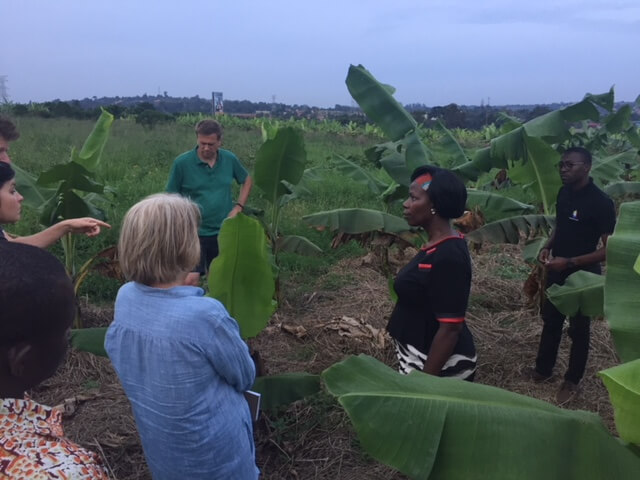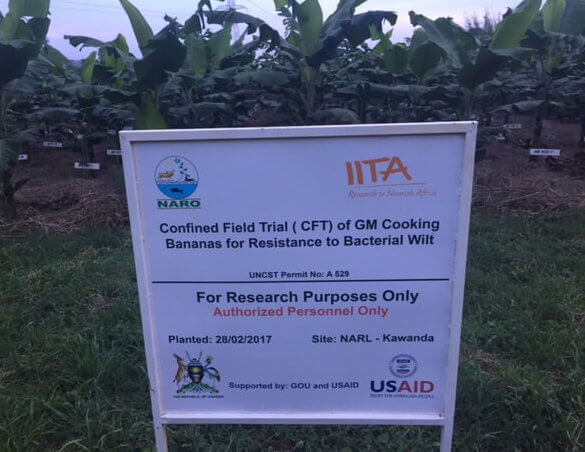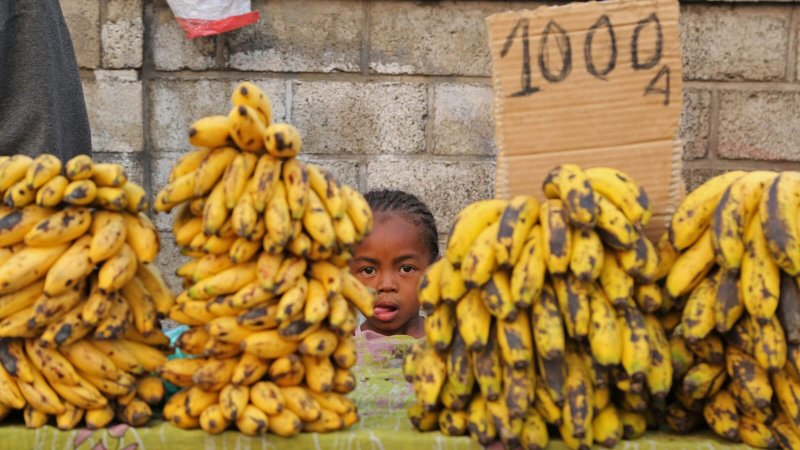I stood in a field of tall banana plants and had to hold back tears. The large green leaves from rows of evenly spaced plants created a dense ceiling above us, and formed a cave behind us as we clumsily trekked across the ruts and mounds in shoes designed more for the ballroom than the plantation. A group of scientists and journalists from Ghana, the UK, Uganda, and the USA made their way to the heart of the field as the sun rapidly set on the National Agriculture Research Laboratory (NARL) in Kawanda, Uganda. The facility is about 10 kilometers north of the capital, Kampala. We traveled together to witness (and celebrate) a great step forward in the mission to aid East Africa’s poorest subsistence farmers and ensure the availability of a food staple that feeds millions in the region.
The ride to Kawanda was slow. We snaked through dusty standstill traffic in a minivan, jammed amongst fumy cars, buses, and noisy trucks. The bodabodas (motorbikes) were the only vehicles moving with any authority, as even those on foot seemed to be making faster progress.
The glacial pace provided us ample opportunity to study the fruit stands encamped along the roadside and there was a common theme—large green bunches of matooke (ma-tok-ae) freshly cut from the tree. Matooke are cooking bananas. To the visitor they look like the familiar dessert banana, maybe a little larger and pointier. To my untrained eye they didn’t look much different from bananas in a New York City produce aisle, but locals could tell you about varieties and flavors just from looking at a bunch in the market.
In this region the matooke is a daily staple. They are starchy with mild flavor, and are prepared by steaming the pulp and covering it with a sauce or stew. The closest parallel to the westerner it is the plantain, but to the people of the African lakes region the matooke is the foundation of the diet, much like rice, noodles or potatoes in other parts of the world.
Threatened by Disease
Production of this dietary cornerstone is under threat. A bacterial disease known as banana Xanthamonas wilt (BXW) infects the plants, and they rapidly succumb in deadly decline. The disease first presents as a notable decrease in vigor, followed by leaves that yellow, wilt, and die.
The farmers of the region refer to their simple plot of crops as their “garden,” which says a lot. There is intimacy in a garden that separates it from a farm. It is personal. Their garden feeds them, sustains their families. Each plant is special and honored.
When the disease hits it spreads rapidly through matooke garden, leading to devastating losses. Once symptoms are present the trees must be cut down and burned. A new productive replacement tree takes years to grow. The garden lives as disease dictates.
The farmers of the region do not have the options of western farmers. There are limited chemicals available to combat microbial pathogens and nematodes (soil worms), so they rely on impeccable sanitation and careful agronomic practices to avoid problems in the first place. Tools are bleached, hands are washed, knee-high rubber boots are splashed in disinfectant before entering the garden. Rigorous prophylaxis is the only defense in a place not blessed with alternative solutions.
Or so it was.
A Solution for Africa, From Africans
Government scientists in Uganda and Kenya have employed the strategies of genetic engineering to address the problem. Over the last thirty years, scientists worldwide have characterized the genes that fortify disease resistance in plants in hundreds of plant species. We eat the genes and their encoded products in every bite of apple, lettuce, rice, or any plant. Resistance genes are present in all plants, and the right combination of genes is the blueprint to a powerful defense against pathogens.
The resistance genes from sweet pepper have been studied for decades. Dr. Leena Tripathi and her team at the International Institute of Tropical Agriculture then moved two specific resistance genes (called HRAP and PFLP) from sweet pepper into matooke. Years later, the plants are beautiful, standing tall, green and strong, even in the presence of the disease.
Standing beneath them is breathtaking. I stood and starred up at a cure for starvation. Maybe these plants would not feed the world, but they could bring desperately-needed security to the plates of East African small farmers.
It was in that canopy of disease-resistant plants that Dr. Priver Namanya told us the story of the modified matooke, and its success in conferring resistance to bacterial wilt. She kindly escorted us to the field, in flip flops and a bright flowered skirt, smiling the whole time as she showed us her work. You could tell she was proud of the solutions that she helped create and foster. She told us about the genetics that also fought off fungal diseases like black sigatoka, also endemic in the region. We stood beneath the proof that this food staple could be protected by a tweak from modern biotechnology.

I think this was the first time I became very emotional in the field. As a scientist, it becomes overwhelming when dedicated professionals like Dr. Namanya explain a problem, like BXW, its devastating effects, and then the solution they devised and made real. It was easy to feel her love of people, her passion, her mission. Then there’s the powerful moment when you touch the physical proof that scientists can indeed protect plants by transferring a gene or two from one plant to another.
And when you turn to the left, the plant labeled “control” is a brown stump with leaves long gone.
The disease resistant banana stands ready to be gifted to farmers that need it. They can then make additional plants from the “suckers”– the daughter plants spouted from the roots that may be cut and replanted to make more disease-resistant trees.
Saving Children from Blindness
On another front Dr. James Dale from the University of Queensland has developed a matooke with an entirely different mission—to save the sight of Ugandan children. Vitamin A deficiency is a tremendous problem in the Developing World, and is commonplace in areas that consume matooke. The matooke banana lacks beta-carotene, the orange pigment found in carrots. When consumed, beta carotene is transferred in the blood, and some of it ends up in the tissues of the eye, where specialized enzymes convert it to vision-saving, life-saving Vitamin A.
Dale’s team provided the genetic information for matooke bananas to produce the healthy orange pigment. They installed a gene from a banana relative called auspina into the matookee. Auspina grows tiny sweet, orange bananas.
Dale says that the high-beta carotene banana plants also are doing well and that they should be deployed within a few short years. The problem is, the children need them today. They needed them yesterday. Children suffer from lifelong effects of vitamin A deficiency if not administered sufficiently in the first four years.
The beta-carotene enriched banana has been growing well for years. Why are these products confined to experimental fields and not meeting human need? This is not a freak “Frankenfood” as Western pundits and Indian eco-terrorists claim. This is a self-propagating, virtually free Vitamin A delivery system in a place where Vitamin A is scarce.
The Frustration of Arrested Solutions
The problem now is not a scientific one. Caring scientists identified the problems of bacterial wilt and vitamin A deficiency, and then took on the challenge of creating solutions. And now, those solutions are ready.
Scientist heroes like Priver Namanya identified new, effective remedies to human problems, crafted from components nature already bestowed on sweet peppers and wild bananas. Scientists simply borrowed bits from nature’s genetic toolbox and place them into culturally familiar crops that local farmers know and local consumers want. Scientists applied technology to help farmers, help children, and improve the environment.
Today these solutions are frozen in place, unable to serve those they were intended to serve. The green, lush plants remain locked behind high fences, the tops wound with razor wire. The carefully designed plants stand behind an official sign that says, “For Research Purposes Only”. The fence, the security, the sign – it makes a heart hurt. These plants are the living options for people who are out of options.

This is a shameful political failure that falls firmly at the feet of western activists, well-financed NGOs, and those that make careers manufacturing non-existent risk around sound technology. Throughout the development of these products for Africans, created in Africa with help of Africans, there has been a steady drumbeat of dissent in the affluent West, as well-fed activists and their “clean food” mantra strive to kill these life-giving products.
The anti-biotech sentiments of the USA and EU resonate loudly in the African continent, as African officials contemplate why they should approve technologies that wealthy countries in the EU reject. There is well-earned suspicion of “western” technology. But in Uganda, where solutions to small holder subsistence farmers thrive behind the security fences and razor wire, there was not even a mechanism to begin to debate, to test, or to deregulate these solutions that their own scientists created.
A Change
That changed on October 4, 2017. I got the text message from a friend in Uganda, and shed a few tears of joy.
The Parliament passed a Biosafety and Biosecurity Bill into law, a step that now provides a roadmap to ensure that these wonderful, live-saving plants may finally be evaluated for safety, efficacy and environmental impacts.
The technologically advanced matooke may now take its first steps toward saving the people it was created to save. Those fenced-in plants now have a chance of escaping their cage and doing some very real good.
Visiting a place with extensive need and widespread poverty is transformative. It makes me grateful for what I have. It makes me grateful for scientists like Drs. Priver Namanya, Leena Tripathi, and James Dale, scientists that have committed their efforts to helping people with scientific solutions.
But it also illuminates how remarkable humanitarian progress may be easily derailed by misinformation, fear, and the penetrating rhetoric of people and organizations sworn to oppose the application of sound technology—even if it means that people will suffer.
The new law is just a first step. If I spend twenty-four hours a day speaking and writing, sharing the story of the fortified matooke, it won’t be enough. Until those new varieties finally reach the hands of the poorest farmers, no efforts will be sufficient.
Technology was created to help people. Now we have a simple job—tell the truth, share the story, and provide a factual alternative to the misinformation. Our voices must lead the fight to ensure that all people have equal access to the best agricultural innovations.
Kevin Folta is a professor and chair of the Horticultural Sciences Department at the University of Florida. He teaches science communication workshops for scientists and ag professionals, and hosts the weekly podcast Talking Biotech. Follow him on twitter @kevinfolta.
This article was originally published at Real Clear Science as “How Western Activists Prevent Africans From Planting a Life-Saving Fruit” and has been republished here with permission.































